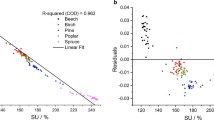Summary
Birch wood meal was phenolated in the presence of sulfuric acid used as a catalyst by changing several reaction conditions, such as, phenol-to-wood ratio, temperature, time, and catalyst concentration to make novolak-type resin. A phenol-to-wood ratio of 2–5, reaction temperature of 60–150 °C, time of 60–120 min, and acid concentration of 1–3% were found to be usable values for obtaining good enough amounts of combined phenol and less amounts of unreacted wood residue. The flow properties (flow temperature and apparent melt-viscosity) of the phenolated wood obtained increased with the increase in the amount of combined phenol, however, decreased with the increase in the moisture content and free phenol in the phenolated wood. Furthermore, it was found that the solubility of the phenolated wood in the organic solvents depended, greatly, on the hydrogen bonding strength of the solvents.
Similar content being viewed by others
References
Alma MH, Yoshioka M, Yao Y, Shiraishi N (1995a) Some characterizations of hydrochloric acid catalyzed phenolated wood-based materials. Mokuzai Gakkaishi 41: 741–748
Alma MH, Yoshioka M, Yao Y, Shiraishi N (1995b) Preparation of oxalic acid-catalyzed resinified phenolated wood and its characterization. Mokuzai Gakkaishi 41: 1122–1131
Alma MH, Yoshioka M, Yao Y, Shiraishi N (1995c) Phenolation of wood using oxalic acid as a catalyst. The effects of temperature and hydrochloric acid addition. J. Appl. Polym. Sci. (in press)
Alma MH, Yoshioka M, Yao Y, Shiraishi N (1996) The preparation and flow properties of HCl-catalyzed phenolated wood and its blend with commercial novolak resin. Holzforschung 50: 85–90
Brandrup J, Immergut EH (1989) Polymer Handbook, 3rd edn. New York: Willey-Interscience, pp. 532–539
Farmer RH (1967) Chemistry in the utilization of Wood. p. 47. New York: Pergamon Press
Kato K, Yoshioka M, Shiraishi N (1990) The thermosetting properties of phenolated wood and its application to moldings. In: Abstracts of the 40th Annu. Meet. of Japan Wood Res. Soc., 1990, Tsukaba, Japan, p. 26
Knop A, Schelb, W (1979) Chemistry and application of phenolic resins. New York: Springer-Verlag, p. 64
Lai YZ (1991) Chemical degradation. In: Hon, D N S and Shiraishi, N (Ed.): Wood and cellulosic chemistry. New York and Basel: Marcel Dekker, Inc., p. 466
Liang BH, Mott L, Shaler SM, Caneba GT (1994) Properties of transfer-molded wood-fiber/ polystyrene composites. Wood Fiber and Sci. 26: 382–389
Lin L, Alma MH, Yoshioka M, Yao Y, Shiraishi N (1994) Liquefaction of wood in the presence of phenol and some properties of the liquefied wood obtained. In: Abstracts of Kyoto Conference on cellulose, Kyoto, p. 121
Ono HK, Sudo K, Karasawa H (1987) Phenolated wood—a source of wood adhesives. In: Abstracts of the International Meeting of the Adhesive Society, Williamsburg, pp. 35–37
Pu S, Shiraishi N (1993) Liquefaction of wood without catalyst II. Weight loss by gasification during wood liquefaction, and effects of temperature and water. Mokuzai Gakkaishi 39: 453–458
Pu S, Yoshioka M, Tanihara Y, Shiraishi N (1994a) Liquefaction of wood in phenol and its application to adhesives. In: Chung-Yun Hse (Ed.): Adhesive Technology and Tropical Wood Composites. Madison, Wisconsin Forest Products Society, pp. 344–345
Pu S, Shiraishi N (1994b) Liquefaction of wood without a catalyst IV. Effect of additives, such as acid, salt, and neutral organic solvent. Mokuzai Gakkaishi 40: 824–829
Rowell RM, Spelter H, Arola AR et al. (1993) Opportunities for composites from recycled wastewood-based resources: a problem analysis and research plan. Forest Prod. J. 43: 55–63
Seta Y, Yoshioka M, Shiraishi N (1993) Characterization of liquefied wood prepared in the presence of phenol. In: Abstracts of the 43th Annu. Meet. of the Japan Wood Res. Soc., 1993, Morioka, Japan, p. 183
Shiraishi N, Tsujimoto N, Pu S (1986) Japan Patent Publication 261358
Shiraishi N (1988) Japan Patent Publication, 88/1456560
Shiraishi N, Kato K (1991) Japan Patent Publication, 43442
Tsujimuto N (1993) Wood-phenol resin fiber. In: Shiraishi N Kajita H Norimoto M (Ed.): Recent Research on Wood and Wood-Based Materials. London and New York: Elsevier Applied Science, pp. 169–185
Whitehouse AAK Pritchett EGK Barnett G (1967) Phenolic Resins, 2nd edn. London: Iliffe Books Ltd., pp. 52–53
Yasumasa Y Kayama T Kikuchi F Usami K Takano I Ogino T Honda O (1973) The properties of the important Japanese woods. Chemical analysis, kraft pul** and paper-making characteristics of the important Japanese woods. Bull. Gov. For. Exp. Sta., No. 253, Meguro, Tokyo, pp. 55–91
Author information
Authors and Affiliations
Rights and permissions
About this article
Cite this article
Alma, M.H., Yoshioka, M., Yao, Y. et al. Preparation of sulfuric acid-catalyzed phenolated wood resin. Wood Sci.Technol. 32, 297–308 (1998). https://doi.org/10.1007/BF00702897
Received:
Issue Date:
DOI: https://doi.org/10.1007/BF00702897




